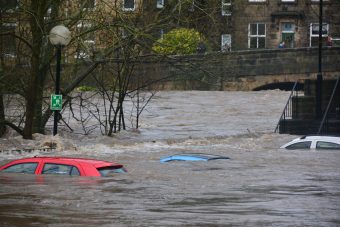
The past few months have been another stark reminder that the climate crisis is getting worse.
Wildfires devastated Hawaii, Canada, and the Canary Islands. Antarctic Sea ice reached its lowest extent since records began in 1978. Multiple ocean heatwaves baked the world’s seas and June, July, August and September all broke monthly temperature records.
One United Nations Environment Programme (UNEP) centre monitoring these events is the Global Resource Information Database – Geneva (GRID-Geneva). Set up in 1985, it is a partnership between UNEP, the Swiss Federal Office for the Environment and the University of Geneva.
With a team of 22 environmental data scientists, GRID-Geneva’s main role is to transform often complex data from multiple sources into accessible information to support the decision-making process related to environmental issues, with a focus on early warnings for environmental disasters.
With the climate crisis intensifying, GRID-Geneva’s work is set to become even more important in the coming years. As UNEP’s Emissions Gap Report 2022 highlighted, current climate policies will result in a 2.8°C temperature rise by the end of the century. This would lead to a large increase in environmental disasters across the world, says Pascal Peduzzi, GRID-Geneva’s Director.
More:
- HOW TECHNOLOGY CAN MAKE THE CLIMATE CRISIS ACCESSIBLE, UNDENIABLE AND ACTIONABLE
- STRONGER INTERNATIONAL COOPERATION IN HIGH EMISSIONS SECTORS CRUCIAL TO GET ON TRACK FOR 1.5°C CLIMATE GOAL
- EXTREME WEATHER IS THE “NEW NORM”
The centre is focused on translating complex data into information that is understandable and actionable. “Most people say they need data, but if you bring them raw data, they don’t know how to deal with it,” says Peduzzi. “So we transform that raw data into graphs and maps and things that people can relate to.”
The centre is connected to 70 data providers—everyone from NASA to the World Glacier Monitoring Service. That network allows it to track global temperatures, forest fires, atmospheric carbon dioxide levels, and sea ice extent, among other markers of climate change. It also tracks a range of other environmental threats, including those linked to nature loss.
GRID-Geneva’s scientists process satellite imagery using remote sensing software, create models from geospatial data using geographical information systems, and generate interactive maps and graphs for automatic updates.
This information is fed into a website, the World Environment Situation Room, which policymakers and the public can access.
As the technology has improved—and expanded to include artificial intelligence—the amount of data that can be processed and interpreted has grown exponentially.
“With our 70 data providers, we don’t have to go in every day and download data,” says Peduzzi. “Their servers are connected to our database, so we get automatic updates, which are reflected in our maps.”
GRID-Geneva not only presents data, but can offer policy recommendations as well, making impact assessments and presenting these to policy makers.

An example of this was the work GRID-Geneva did on sand extraction, an issue that had long flown under the radar.
Globally, humans consume 50 billion tonnes of sand a year, with the material finding its way into everything from buildings to roads. But sand is often dredged from the ocean, a process that sterilizes the bottom of the sea by crushing the microorganisms that feed fish, Peduzzi says.
GRID-Geneva produced a report on sand extraction in 2014, which, Peduzzi says, led to significant media interest. In 2019 and 2022, two other reports were produced, showcasing the damaging effects of dredging.
Last year at the United Nations Environment Assembly, the world’s highest-level decision-making body on the environment, a resolution was adopted stating that GRID-Geneva should “strengthen scientific, technical, and policy knowledge with regard to sand and to support global policies and action regarding the environmentally sound extraction and use.”
Peduzzi says the centre’s goal is to ensure its data is based on solid science and the process is accurate. Then that data is presented to Member States, who will, hopefully, take action.
“We are connectors,” Peduzzi says. “We are the link between the scientific data providers and governments.”
Source: UNEP




